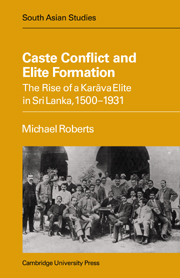Book contents
- Frontmatter
- Contents
- List of figures, chart and maps
- List of tables
- Preface
- Glossary
- List of abbreviations
- Map 1 The Kingdoms of Kotte and Kandy
- Map 2 Some physical features and place names
- Map 3 Present administrative divisions and the contemporary migration patterns of fishermen
- Map 4 The coastal waters of Sri Lanka and southeastern India
- 1 Introduction
- 2 The Karāva in the past
- 3 Caste among the Sinhalese
- 4 Economic opportunities and social relations, 1500s–1790s
- 5 The British period: the economic advances of a Karāva elite
- 6 Social competition, caste conflict and manifestations of Karāva power
- 7 Casteism in South Asian politics during British times: emergent cultural typifications or elite fictions?
- 8 Causal factors in the moulding of Karāva entrepreneurship and the emergence of a Karāva elite
- 9 Concluding remarks
- Tables
- Appendix 1 Problems and cautionary notes concerning the information derived from the plantation directories in the sequential series known as Ferguson's Ceylon Directory
- Appendix 2 A contemporary newspaper account of the reception provided for a Karāva notable on his receiving the title of ‘Mudaliyar of the Governor's Gate’ in 1853
- Appendix 3 A list of caste pamphlets and caste literature in chronological order, 1864–1930
- Select bibliography
- Index
3 - Caste among the Sinhalese
Published online by Cambridge University Press: 30 October 2009
- Frontmatter
- Contents
- List of figures, chart and maps
- List of tables
- Preface
- Glossary
- List of abbreviations
- Map 1 The Kingdoms of Kotte and Kandy
- Map 2 Some physical features and place names
- Map 3 Present administrative divisions and the contemporary migration patterns of fishermen
- Map 4 The coastal waters of Sri Lanka and southeastern India
- 1 Introduction
- 2 The Karāva in the past
- 3 Caste among the Sinhalese
- 4 Economic opportunities and social relations, 1500s–1790s
- 5 The British period: the economic advances of a Karāva elite
- 6 Social competition, caste conflict and manifestations of Karāva power
- 7 Casteism in South Asian politics during British times: emergent cultural typifications or elite fictions?
- 8 Causal factors in the moulding of Karāva entrepreneurship and the emergence of a Karāva elite
- 9 Concluding remarks
- Tables
- Appendix 1 Problems and cautionary notes concerning the information derived from the plantation directories in the sequential series known as Ferguson's Ceylon Directory
- Appendix 2 A contemporary newspaper account of the reception provided for a Karāva notable on his receiving the title of ‘Mudaliyar of the Governor's Gate’ in 1853
- Appendix 3 A list of caste pamphlets and caste literature in chronological order, 1864–1930
- Select bibliography
- Index
Summary
It is one of the arguments in this book that the place of the Karāva caste in the changing system of caste stratification in Sri Lanka was of considerable importance for the social and economic advances secured by some of the Karāva. It follows that consideration should be paid to the system of caste interaction among the Sinhalese and the place of the Karāva within this structure (viewed morphologically) before the Karāva elite began to make its presence felt. Before taking up these insular details, however, readers will be introduced to the general principles of caste interaction in the Indian cultural region. In presenting this generalised description, the opportunity is taken to introduce concepts which will be referred to from time to time in the course of this book.
Caste in the Pan-Indian context
Caste is a social and cultural category. It is an identity, a label. But it is also more than that. As Edmund Leach has stressed, ‘a caste does not exist by itself. A caste can only be recognised in contrast to other castes with which its members are closely involved’ in a network of relationships. ‘These relationships extend to economic, religious and political spheres; only kinship is excluded.’
Caste is also a quality. ‘The quality resides in the blood. And blood is graded from very pure to extremely defiling.’ In Sinhalese society this is expressed in the concepts of pirisidu (pure) and hoňda (good) as opposed to apirisidu (impure) and naraka (bad). Those bearing the latter quality are, therefore, of low status – hīna or paha⃛ jāṫi. Such concepts embody the notion of a hierarchy.
- Type
- Chapter
- Information
- Caste Conflict Elite Formation , pp. 35 - 74Publisher: Cambridge University PressPrint publication year: 1982



